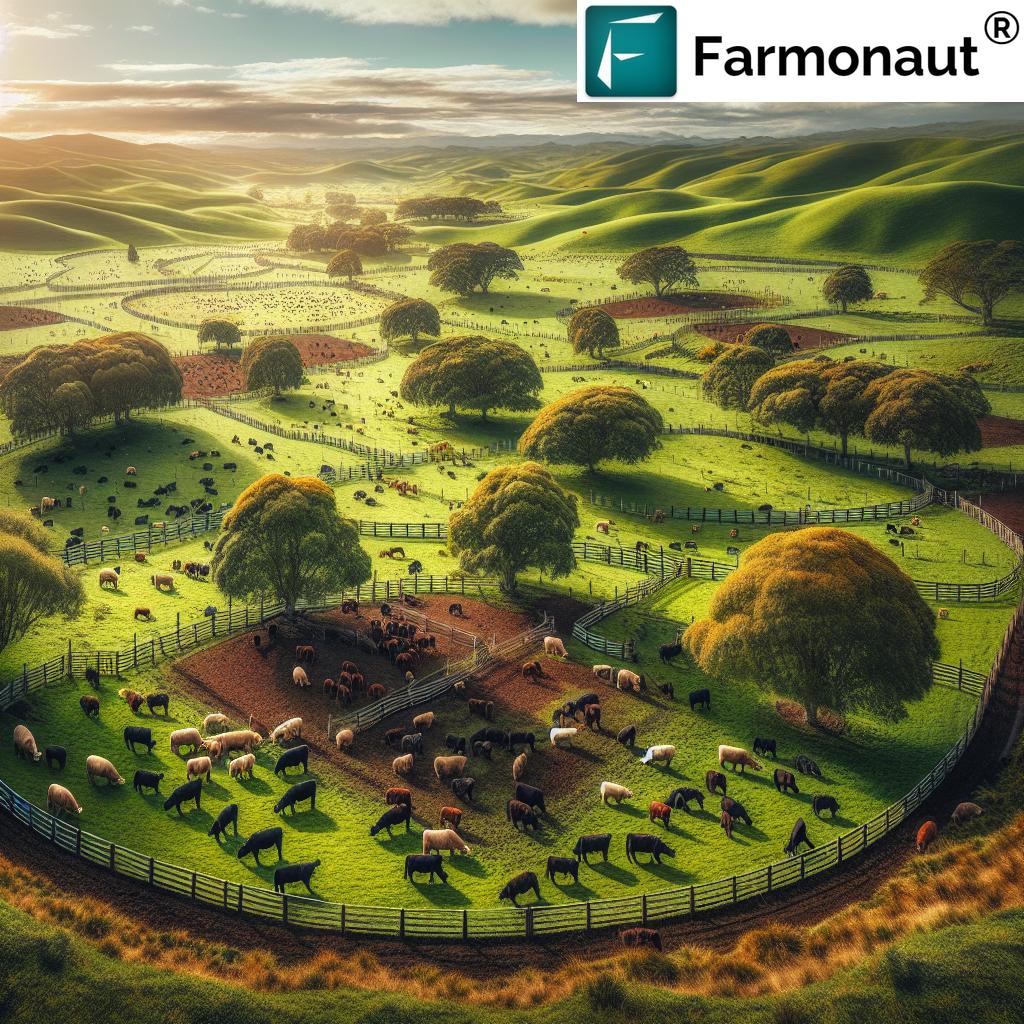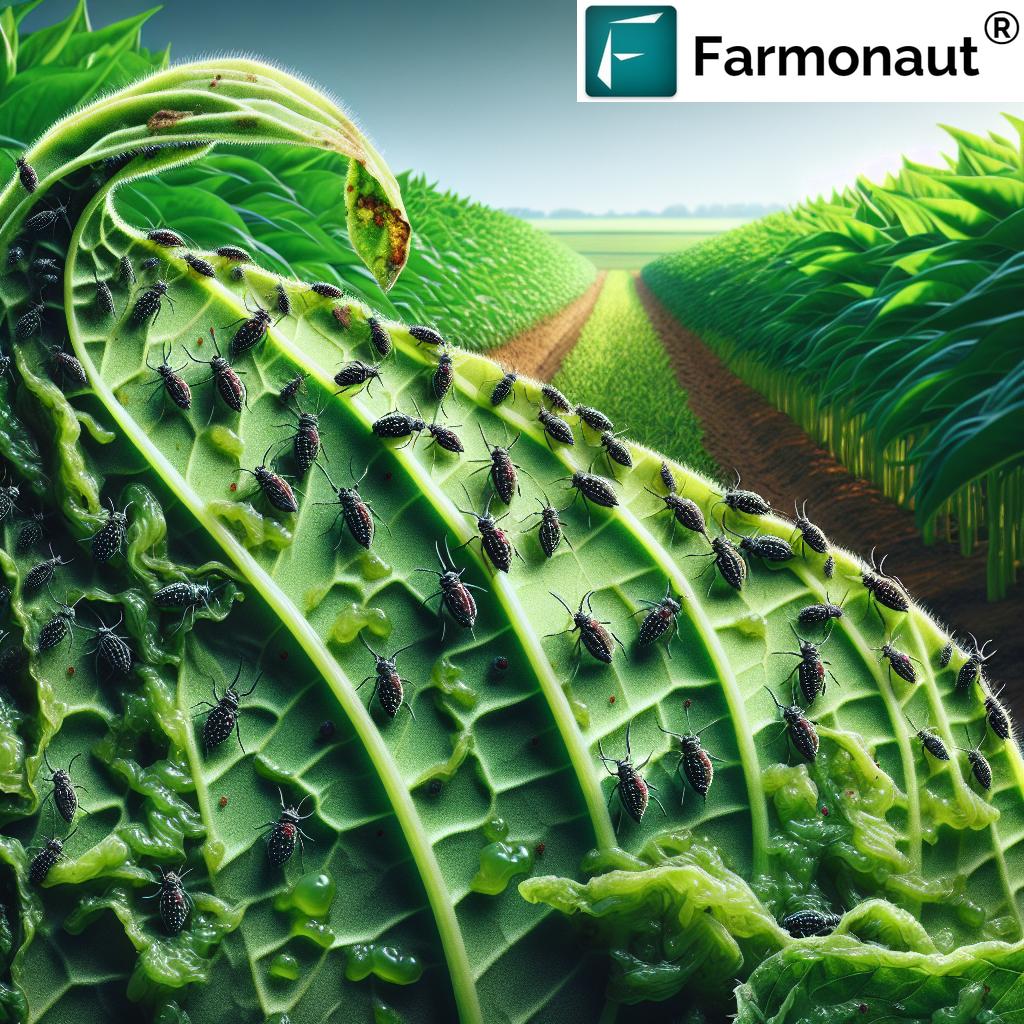Grazing Management: 7 Shocking Land Hacks Revealed!
“Rotational grazing can increase pasture productivity by up to 30% compared to continuous grazing systems.”
Table of Contents
- Introduction
- Grazing Management Overview
- The 7 Shocking Grazing Management Hacks
- Improving Soil Health in Grazing
- Silvopasture Integration for Sustainability
- Conservation & Forest Grazing Considerations
- Grazing Monitoring Techniques & Adaptive Management
- Best Practices for Ultimate Productivity
- Farmonaut: Innovations in Pasture Management
- Grazing Management Techniques: Impact Overview
- Grazing Management Challenges & Real-World Solutions
- FAQs: Grazing Management
- Conclusion
- Farmonaut Subscriptions
Introduction: Grazing Management for Sustainable Agriculture
Grazing management forms the backbone of sustainable agriculture, farming, and forestry. By leveraging the power of controlled grazing on pasture lands, we can unlock a world of productivity, boost biodiversity, and maintain soil health for generations. As stewards of the land, our collective mission is clear: manage our livestock efficiently, apply evidence-based grazing management systems, and adopt advanced tools like Farmonaut to propel our journey toward sustainable livestock grazing.
This blog reveals 7 powerful and sometimes surprising land hacks for optimal grazing management—from traditional methods to cutting-edge digital solutions. Together, we’ll examine rotational, strip, mob, continuous, deferred, silvopasture, and conservation grazing, explore how to improve soil health in grazing, maximise forage utilization strategies, and create more resilient, biodiverse pasture systems.
Discover how our decisions—on system choice, adaptive pasture management practices, and ongoing monitoring—directly determine productivity, ecological balance, and overall environmental health.
Grazing Management Overview: Why It Matters for Land, Livestock & Sustainability
Grazing management is the strategic process of planning, implementing, and optimizing the controlled feeding of livestock on pasture lands. Our main objectives include maximizing forage utilization, preventing overgrazing, enhancing soil fertility, and supporting robust biodiversity in pasture lands—while ultimately promoting both livestock and land productivity.
- Forage Utilization: Ensuring that forage is consumed at optimal rates for sustained growth.
- Livestock Productivity: Balancing animal health and output with pasture longevity.
- Soil & Ecosystem Health: Using practices that support organic matter buildup, soil structure, and water retention.
- Biodiversity Support: Managing species and grazing patterns to encourage diverse plant and animal life.
With mounting climate and economic pressures, grazing management is more than a traditional practice—it’s an essential part of modern agriculture and sustainable forestry.
“Healthy grazing management boosts soil organic matter by 15%, enhancing biodiversity and long-term land sustainability.”
The 7 Shocking Grazing Management Hacks to Transform Your Land
1. Continuous Grazing: The Simplicity Trap
With continuous grazing, livestock have open access to entire pastures throughout the season. While this management system is straightforward and reduces labor and infrastructure costs, it comes with significant challenges:
- Increased risk of overgrazing—leading to soil degradation and weed encroachment.
- Declining forage quality and yield as favored plant species are continually grazed.
- Loss of soil fertility and compacted areas near water points.
If unmanaged, this system can undermine long-term sustainability, despite initial ease of implementation.
2. Rotational Grazing Systems: The Gold Standard
Rotational grazing systems involve dividing pasture lands into multiple paddocks, then rotating livestock among them. Each paddock receives set periods of rest and regrowth:
- Prevents overgrazing and encourages natural manure distribution.
- Promotes vigorous forage regrowth and soil health.
- Increases forage utilization efficiency and productivity by up to 30%.
- Improves resilience to weather swings by spreading grazing pressure.
Through this approach, we support sustainable livestock grazing and ensure future ecosystem balance.
3. Strip Grazing: The Precision Approach
Strip grazing—an intensive variant of rotational systems—confines livestock to narrow strips of forage for short durations (typically less than a day), before moving them to the next strip. This practice ensures:
- Uniform forage consumption and minimal trampling or waste.
- Improved forage utilization and faster regrowth.
- Enhanced pasture management practices by controlling grazing intensity.
4. Mob Grazing: Mimicking Nature’s Migration
Mob grazing is an ultra-high-density system inspired by natural wildlife movements. Livestock are densely packed in a paddock for very short periods and then moved rapidly. This method:
- Boosts soil organic matter by trampling forage into the soil.
- Improves soil health, water retention, and biodiversity.
- Promotes the recovery of diverse plant species and mimics natural grazing patterns.
5. Deferred Grazing: Saving for the Tough Season
Deferred grazing is our strategic tool for forage availability when feed is usually scarce. Here’s what makes it unique:
- Some pasture areas are rested (not grazed) during peak growth, stockpiling forage for later, leaner times.
- Manages risk from weather variability and droughts by ensuring feed reserve.
- Allows for recovery and optimal forage utilization over the annual cycle.
6. Silvopasture Systems: Harnessing the Power of Trees
By introducing trees into pastures, or grazing beneath established woodlands, silvopasture systems create a unique trifecta of livestock, forage and woody vegetation:
- Improves microclimates for livestock and plants (shade, shelter).
- Enhances soil fertility via leaf litter and root dynamics.
- Encourages biodiversity and opens new income streams (timber, non-timber products).
Discover more about the implementation, science, and economics of silvopasture systems on the Farmonaut Forest Advisory page!
7. Conservation Grazing: Livestock as Land Stewards
Conservation grazing, also known as targeted or prescribed grazing, utilizes livestock as part of a restoration strategy for ecosystems such as grasslands, wetlands, and forests. By controlling species composition and vegetation structure, conservation grazing:
- Helps maintain biodiversity and supports rare plant species.
- Controls invasive species and reduces wildfire risk.
- Restores ecological balance and supports targeted habitat goals.
Great for sensitive areas and reserves, this method demands diligent monitoring and flexible planning.
Grazing Management Techniques: Impact Overview
| Technique | Est. Livestock Productivity Increase (%) | Soil Health Improvement (Rating) | Biodiversity Boost (No. of Species ↑) | Forage Utilization Efficiency (%) | Water Retention Improvement (Rating) |
|---|---|---|---|---|---|
| Continuous Grazing | 0-5% | ★☆☆☆☆ | Low (baseline) ↓ |
55-65 | ★☆☆☆☆ |
| Rotational Grazing | 20-30% | ★★★☆☆ | Medium (10-20 ↑) | 70-80 | ★★★☆☆ |
| Strip Grazing | 25-35% | ★★★☆☆ | Medium/High (15-30 ↑) | 85-90 | ★★★☆☆ |
| Mob Grazing | 25-35% | ★★★★☆ | High (25-40 ↑) | 80-90 | ★★★★☆ |
Improving Soil Health in Grazing: Land Hacks for Resilient Pastures
Our ability to improve soil health in grazing is the foundation for long-lasting productivity and sustainability. Healthy soil teems with beneficial microbes, organic matter, and nutrients. Here are vital strategies and practices:
- Preventing Overgrazing: Regularly monitor forage height and soil compaction to avoid lasting degradation.
- Promoting Organic Matter: Allow some residue to decompose—boosting organic content and supporting soil structure.
- Supporting Water Infiltration: Use rotational systems to stop livestock from compacting wet areas (especially after rain).
- Enhancing Fertility Naturally: Evenly distribute livestock for balanced manure coverage.
Explore how Farmonaut’s satellite-based tools can help track soil health changes and optimize management with our specialized service Farmonaut Carbon Footprinting—perfect for monitoring soil organic carbon and guiding sustainable decisions.
Silvopasture Integration for Sustainability
Integrating silvopasture systems into pasture management offers next-level rewards for both profitability and ecosystem resilience:
- Thermal comfort: Trees shade livestock, reducing heat stress and raising productivity.
- Nutrient cycling: Deep-rooted trees bring up nutrients for forage and enrich soil with organic matter.
- Biodiversity surge: Provides more habitat (birds, insects, small mammals) and boosts plant species variety.
- Risk mitigation: Multiple products (timber, fodder, livestock) diversify income and buffer climate risk.
Remember, effective silvopasture management requires monitoring livestock impact on young trees and adjusting rotational grazing periods.
For digital monitoring—whether in forestry, crop plantation, or large-scale farm management—see how Farmonaut’s Large Scale Management Solution enables holistic, satellite-powered control of your operations.
Conservation & Forest Grazing Considerations
Forest Grazing: Tread Carefully, Reap the Benefits
Grazing in forested areas can deliver additional forage and help manage invasive undergrowth, but special care is needed:
- Soil Compaction: Limit stocking densities to prevent root damage and preserve water infiltration.
- Erosion Prevention: Avoid grazing slopes and stream sides during wet weather or freeze-thaw cycles.
- Forest Regeneration: Monitor seedling survival and adapt grazing periods as needed.
- Protecting Sensitive Zones: Use fencing or rotational exclusion to support regeneration in at-risk areas.
Conservation Grazing in Native Grasslands
Applied correctly, conservation grazing is a powerful tool for restoring threatened grasslands and natural ecosystems. Adjust intensity based on ecological monitoring and ensure adaptive management in response to changing weather patterns, species shifts, and forage availability.
For advanced data and documentation, Farmonaut’s Fleet & Resource Management can help operators coordinate livestock movements and reduce fuel and operational costs on large reserves.
Grazing Monitoring Techniques & Adaptive Management
Sustainable grazing management hinges on robust grazing monitoring techniques and the ability to adapt plans in real time. Here’s our approach:
Key Steps in Grazing Monitoring
- Pasture Condition Monitoring: Check forage height, biomass, and ground cover before, during, and after grazing periods.
- Soil Health Tracking: Evaluate soil compaction, organic matter content, and water infiltration using sampling and satellite tools.
- Livestock Performance: Regularly assess animal health and weight gain, aligning with management goals.
- Ecological Indicators: Identify indicator species (plants, insects) to track biodiversity trends.
Adaptive Management in Practice
- Remain flexible—adjust stocking densities, paddock rotation frequency, or grazing intensity based on real-time data and weather patterns.
- Use digital platforms for tracking grazing patterns and responding quickly to forage flushes or deficits.
We recommend integrating data-driven grazing monitoring techniques available on the Farmonaut Traceability Solution for secure, auditable livestock movement and pasture records.
Best Practices for Ultimate Productivity
Our Top Pasture Management Recommendations
- Planning for Diversity: Mix forage species and encourage a mosaic of plant types for improved biodiversity and resilience.
- Infrastructure Matters: Invest in durable fencing, water systems, and shade structures; this supports efficient rotational grazing systems and reduces labor.
- Education and Training: Stay up to date on management practices with ongoing training and digital platforms, including Farmonaut’s advisory suite.
- Rest and Recovery: Honor rest periods in your paddocks; monitor regrowth and adjust grazing intensity to maintain optimal pasture condition.
- Multi-Tool Monitoring: Combine on-the-ground checks with satellite imagery analysis for rapid, accurate pasture assessment.
- Regenerative Focus: Use trampling to stimulate soil building and seed incorporation where organic matter is low.
Farmonaut provides android, iOS, web/browser App, and API access for robust farm monitoring and operational control. Developers and agri-businesses can leverage Farmonaut’s Satellite Data API and Developer Documentation for custom integration with their own pasture management apps and platforms.
Farmonaut: Innovations in Pasture Management
At Farmonaut, we are committed to pioneering accessible, high-impact technologies for every aspect of grazing management and pasture health monitoring.
Farmonaut’s Platform Features:
- Satellite-Based Crop and Pasture Health Monitoring: Analyze vegetation health, soil moisture, and forage availability instantly across your lands.
- AI-Powered Advisory: Get personalized, real-time insights and weather forecasts for adaptive management (Jeevn AI System).
- Blockchain-Based Traceability: Track every stage—ideal for livestock certification and conservation grazing documentation.
- Resource Management Tools: Track fleet, vehicles, and assets for operational efficiency and reduced emissions.
- Carbon Footprinting Module: Monitor and minimize environmental impact, supporting both regulatory compliance and sustainable livestock grazing goals.
- Global Accessibility: Android, iOS, web app availability and streamlined API integration.
These tools empower us to monitor, manage, and adapt all key elements of the grazing management process, keeping our pastures resilient, highly productive, and sustainable.
Grazing Management Challenges & Real-World Solutions
While grazing management opens the door to many opportunities, we must address several practical challenges:
- Climate Variability: Unpredictable weather patterns may impact forage growth, requiring adaptive management strategies.
- Economic Constraints: Upfront infrastructure investment (fencing, water) and ongoing operational costs must be planned.
- Regulatory Compliance: Navigating permits and environmental regulations can be intricate but is essential to sustainable grazing.
- Knowledge Gaps: Advanced grazing systems require training and ongoing education for optimal results.
Utilize digital advisory platforms like Farmonaut’s Jeevn AI system for expert, customized solutions and management guidance regardless of your region (see more on the Crop Plantation and Forest Advisory page). And for all your pasture and crop verification needs, satellite-based crop loan and insurance eligibility support is just a click away.
FAQs: Grazing Management, Soil Health, & Farmonaut
What is the primary benefit of rotational grazing systems?
Rotational grazing systems prevent overgrazing and give each paddock periods for rest and regrowth. This maximizes forage utilization, improves soil health, and increases livestock productivity sustainably.
How does grazing management impact soil health?
Thoughtful grazing management boosts organic matter content, prevents soil compaction, and encourages beneficial microbial life—essential for crop and pasture productivity.
What are the key principles of sustainable livestock grazing?
- Balance forage supply with livestock demand
- Maintain soil fertility
- Protect biodiversity
- Adjust grazing intensity and timing based on monitoring data
How can I monitor grazing effectiveness on large ranches or reserves?
For large areas, integrate satellite-based crop and pasture monitoring (via Farmonaut web or mobile app) for real-time insights on vegetation health, soil moisture, and grazing patterns.
Can Farmonaut’s technology help with regulatory compliance and sustainability?
Yes! With blockchain-based traceability and carbon footprinting, Farmonaut helps document sustainability practices and compliance, boosting access to green financing and certification.
Conclusion: Unleash the Full Potential of Grazing Management
Sustainable grazing management is not just about moving livestock—it’s about managing land, soil, ecosystems, and economic resources with precision and care. By selecting the right grazing systems, such as rotational and silvopasture, using best practices, embracing regular monitoring, and leveraging technological innovation (like Farmonaut’s platform), we can maximize productivity and ensure long-term environmental health.
- Choose your management system wisely and adjust with the seasons and climate.
- Prioritize soil health and biodiversity in pasture lands—they are the lifeblood of your operation.
- Utilize modern digital tools for monitoring, forecasting, and optimizing every hectare.
Join us on this journey as we continue to innovate, educate, and support the future of sustainable agriculture, farming, and forestry!
Farmonaut Subscription Plans
Explore affordable, scalable subscription options that make precision grazing management accessible for operations of all sizes, delivered by Farmonaut’s mobile, web, and API platforms.













I truly appreciate your technique of writing a blog. I added it to my bookmark site list and will
Great information shared.. really enjoyed reading this post thank you author for sharing this post .. appreciated